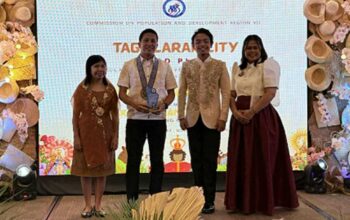
IN which ever order, these three words incidentally define the Boholano through the years.
Recently too, the National Museum of the Philippines unveiled important markers of these equally important structures in Tagbilaran, in an apparent move to remind Boholanos of the way it was. And the way it is.
Two houses, at least half-a-century old which figured out prominently in Bohol history, an old Spanish school for girls and the city plaza are the latest in the list of Important Cultural Properties (ICP) that formally gets government supervision and upkeep in their preservation and conservation.
This as the National Museum of The Philippines (NMP) conferred to Bohol Provincial Government, the City Government of Tagbilaran and owners of these structures the certificates that formally declared these among the country’s important cultural properties.
The certificates which were signed by the NMP go with bronze ICP markers that were either unveiled on that day, or would be displayed prominently in these sites.
Signing the ICP certificates were NMP Director for Visayas Museums Atty Ma. Cecilia Tirol and Governor Erico Aristotle Aumentado represented by Atty Handel Lagunay for the Escuela de Niñas and the Bulwagang Rizal (Plaza Rizal which used to be Plaza del Principe, to City Mayor Jane Yap and heritage house owners: Architect Gloria Balili-Katz for the Balili Heritage House along Jacinto Borja Street and Norma Beldia for the Beldia Heritage House in Poblacion Ubos, Tagbilaran City.
Governor Aumentado, who has seen the huge potential for these ICPs as tourism sites, has said that these could be a great help in attaining Bohol’s strategic agenda.
BELDIA HERITAGE HOUSE
Situated in Sitio Poblacion Ubos, the historical value of this house is beyond contest: originally owned by an affluent businessman and gobernadorcillo, this served as the temporary municipal hall of Tagbilaran before it was transferred to the also abandoned hall on top of the bluff overlooking Sitio Poblacion Ubos.
There are also claims that the house hosted Don Manuel Timoteo Hidalgo, Jose Rizal’s brother-in-law in the former’s exile in Bohol, and possibly Jose Rizal himself when the Dapitan-exiled doctor toured Bohol sometime in 1894.
Accordingly built in 1858 by Don Esteban Butalid, the imposing house sports a Chinese-pagoda style clay tile roof, something that could indicate the sangley culture pervasive in this port and trading center, something that survives until now.
The two-storey house has a floor plan in a general u-shaped form to afford an inner courtyard, but this is currently roofed-over, providing yet an enormous space for the house.
Sporting a design carried over by Spanish houses, a huge gallery extended from the massive coral stone walls, affords a wide airy feel, with still polished wood planks as floor, even if its old wooden panels have been long replaced by recent building materials.
In 1971, Judge Antonio Beldia bought the house from the Butalid-Calceta-Gallares family corporation, thus the name.
Beldia heirs, represented by Archt. Norma Beldia now administers the house.
BALILI ANCESTRAL HOME
Tucked behind a huge garden of overgrowths and under the shadows of stately century-old acasia trees, is another treasure of a house that has seen its best days as the favored venue for the who’s who in Bohol’s civil and political societies; it also necessarily attracts national figures in the country’s political sandbox.
Considered to be one of Tagbilaran’s most prized ancestral houses, the Balili House is built by Eladio Balili, a history teacher businessman into lumber, furniture and construction, as a bachelor’s retreat in 1934, and is among the best preserved Art Noveau structures still standing right now right inside the vast Balili estate.
Built in the period of American chalets, the Balili mansion builders have no concern for the use of wood as evidenced by the profuse arches, wooden posts, friezes, intricately carved wooden calados, wooden canopies and gracefully rounded corners sure lend to the mansion its innate charm.
And like the typical poured concrete made famous at those times, the mansion can be accessed through a grand concrete staircase leading to a patio that provides a commanding view of the gardens.
Owing to its being frequented by Bohol’s and the country’s socialites, Balili house became a natural comfortable home and command center of the Japanese imperial army occupying Bohol during the second world war.
Thanks to Archt Gloria Balili-Katz, the youngest child of the owner, the house still mysteriously kept its charm, despite its being rented out in the late 19th century.
ESCUELA DE NIÑAS
In response to the Spanish Education Decree of 1863 by Queen Isabella II of Spain, two stone buildings were built in the 1900s, which would act as the primary school here, for primary education as ordered was to be free and teaching of Spanish was compulsory.
By the end of the Second World War, the Escuela de Ninos was damaged that it has to be demolished to give way to the present Philippine National bank building.
During the American period, the surviving Escuela de Niñas building was still used as a school by the Thomasites: school teachers deployed by the U.S. Government to establish an American educational system in their newly occupied territory.
Needless to say, in the building was molded the minds of Bohol leaders, who have charted a way to bring Boholwhere it is now.
In June 1958, the building, since it has ceased operation as a school, was opened to the public as the Bohol Provincial Library, and in the next forty years it catered to the educational needs of Boholanos.
In July of 2007, the building was inaugurated as the NMP Bohol Branch and served as a repository of archaeological and ethnographic artifacts, as well as paleontological, geological, botanical and zoological specimens collected from the province.
But after the 2013 Bohol Earthquake, the building also became the headquarters of NMP’s Bohol Heritage Task Force, where experts and technical personnel assessed the damages sustained by Bohol’s declared built heritage, most of which have already been restored.
July 22 of 2018, after Bohol donated to the NMP the old provincial Capitol, the Escuela de Ninas would soon be an open use facility until Bohol Tourism Office put up their office in the building.
PLAZA RIZAL (Plaza del Principe)
Established in accordance with the 1573 ordinance of King Philip II of Spain which prescribed the layout of towns in the Spanish colonies, Plaza Rizal, which used to Plaza del Principe, is situated between the Tribuna (old Capitol) and the St. Joseph’s Cathedral, the seat of the Bishop of the Diocese of Tagbilaran.
From stretches of open spaces and greens at the turn of the 20th century, it was during the American period when plazas were adorned with, the Rizal Monument for example, erected in 1912, for which the site is named today, and the neoclassical kiosk, which was the formal bandstand.
The plaza now also features a fountain was built in the latter half of the 20th century, and tucked in the northern corner of the plaza is concrete kiosk created by Bohol’s first architect, Venerando Dumadag, for players of chess, the favorite sport of Bohol’s famous son, Carlos P. Garcia.
A regular venue for public debates, the plaza has seen heated altercations: politicians campaigning, faith-based groups in their public evangelization missions and ambulant vendors eking out their family’s next meal.
Then a regular public area where people can pass time after celebrating mass, the plaza was then adorned with President Garcia’s statue, as created by Boholano National Artist for sculpture Napoleon V. Abueva.
This statue has long been transferred to the courtyard of the National Museum in Bohol, across the plaza.
MORE TO COME
With the unveiling and turnover of markers, NMP Director Tirol said these are just four yet of the 12 ICPs that Tagbilaran City has identified as its important cultural treasures. She also reminded Boholanos that preservation and conservation of these properties mean community stewardship of these invaluable heritage structures. For City Mayor Jane Yap, she assured that this ensures that Tagbilaran City legacy lives and that the task of cultural preservation and conservation that the city commits to, would also be a legacy telling the people’s creativity and resiliency. (PIA-7/Bohol)



